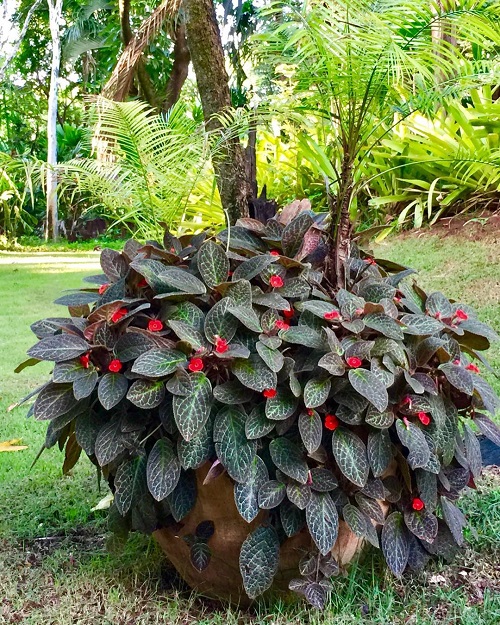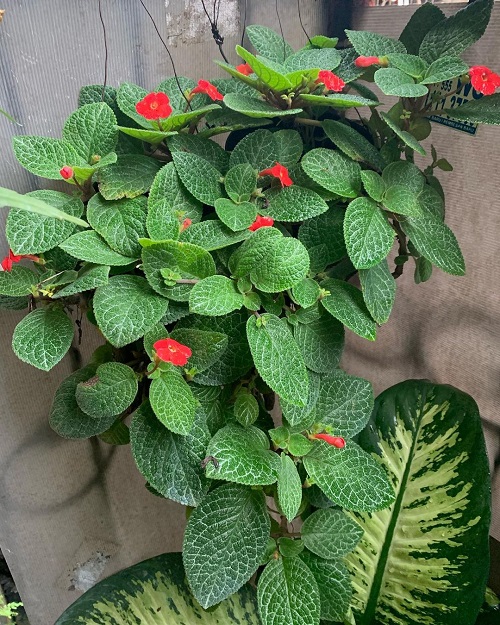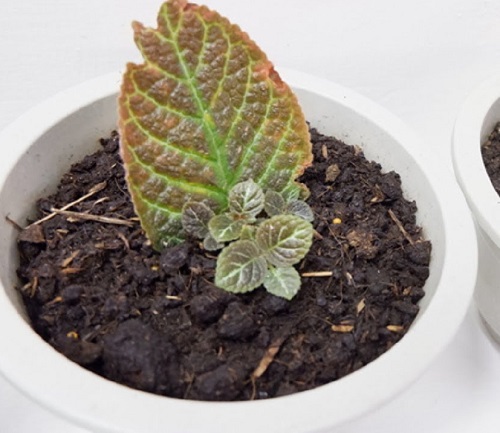Episcia Cupreata stands out with its vibrant foliage and can be a fantastic addition to any garden! Here’s how to grow it easily.

Episcia Cupreata, commonly known as the Flame Violet or Chocolate Soldier, is a strikingly beautiful plant that captures attention with its vibrant colors and delicate foliage. Let’s have a look at how to grow and maintain it.
Read about Care and Growing Astrantias here
Episcia Cupreata Information

Episcia cupreata is very popular for its year-round display of captivating, colorful leaves that grow in a rosette formation, reaching a length of 2-3 inches (5-8 cm). They exhibit a stunning combination of green, coppery brown, lavender, or pink hues with light green or silver veins. There is a wide range of patterns and colors available, all of which possess an irresistible iridescent sheen.
These plants rapidly spread across the surface of the planter or trail downwards. These stolons create a striking visual effect, making flame violets an excellent choice for hanging baskets where their cascading growth can be showcased.
During spring through fall, Episcia cupreata grows vibrant flowers. Delicate, tubular blooms rise above the foliage, predominantly in red shades, although variations in orange, pink, or yellow may also be found.
The flower tips flare out, resembling trumpets, and sometimes exhibit fringed edges. Deep within the trumpet lies a yellow eye, adding further charm to these blossoms.
Here is our Alocasia Odora Care and Growing Guide
Propagating Episcia Cupreata
Propagating Episcia cupreata is easy using divisions and cuttings.
Division
- Carefully remove Episcia cupreata from its pot and gently separate the individual stems or clumps.
- Ensure that each division has roots attached.
- Plant each division into its own pot, using well-draining soil suitable for Episcia cupreata.
- Water the newly potted divisions and place them in a warm, humid location with bright indirect light.
- Maintain appropriate moisture levels and allow the plants to establish themselves.
Stem Cuttings
- Select a healthy Episcia cupreata stem that is several inches long and has several leaves.
- Make a clean cut just below a leaf node using a sharp, sterile knife or scissors.
- Remove the leaves from the lower portion of the cutting, leaving a few leaves at the top.
- Dip the cut end of the stem in a rooting hormone (optional).
- Plant the cutting in a pot filled with a well-draining potting mix or a mixture of peat moss and perlite.
- Keep the soil moist but not waterlogged, and place the cutting in a warm, humid location with indirect light.
- After a few weeks, the cutting should develop roots and can be treated as a mature plant.
Propagate Any Plant Cutting Quickly Using this Trick
Best Episcia Cupreata Varieties
- ‘Chocolate Soldier’ showcases dark foliage adorned with silver veining. On the other hand,
- ‘Tropical Topaz’ displays a delightful combination of light green leaves and yellow flowers.
- If you prefer a touch of elegance, ‘Silver Sheen’ features silver-gray, crinkled leaves accompanied by vibrant red blooms.
Check out Alocasia Dragon Tooth Care and Growing Guide here
Requirements for Growing Episcia cupreata

Location
Provide Episcia cupreata with bright, indirect light, as insufficient light can hinder blooming. Position the plant near a bright window, avoiding direct sunlight.
Similar to its cousin African Violet, Episcia cupreata thrives under artificial light as well. Ensure adequate lighting conditions, whether natural or artificial, to promote healthy growth and encourage blooming in your flame violets.
Soil
Episcia cupreata prefers slightly acidic soil, and peat moss helps to create a slightly acidic pH. It also provides moisture retention and good aeration.
Find out some Helpful Hacks to Improve Your Garden Soil for Free here
Adding perlite or coarse sand to the soil mix helps improve drainage and prevents the soil from becoming compacted. It increases aeration and prevents the roots from becoming waterlogged.
Water
Episcia cupreata prefers slightly moist soil. Avoid overwatering, as it can lead to root rot. Allow the top inch (2.5 cm) of the soil to dry out between waterings.
Here is How to Treat Root Rot in Houseplants Like a Pro
Temperature
Daytime temperatures: Ideally, maintain temperatures between 70°F to 80°F (21°C to 27°C) during the day.
Nighttime temperatures: Episcia cupreata prefers slightly cooler temperatures at night, ranging from 60°F to 70°F (15°C to 21°C).
Humidity
Episcia cupreata prefers humidity levels between 50% and 70%. This higher humidity helps mimic its natural habitat and promotes healthy growth.
Place your Episcia cupreata near other plants to create a microclimate with increased humidity. As plants transpire moisture through their leaves, the surrounding air becomes more humid. You can also keep its pot on a pebble tray filled with water.
Here are 10 Ways To Increase Humidity For Houseplants That Work
Episcia cupreata Care

Fertilizer
Use a balanced, water-soluble fertilizer with a ratio such as 20-20-20 or 10-10-10. Alternatively, you can opt for a specialized houseplant fertilizer formulated for foliage plants.
Follow the instructions on the fertilizer packaging for dilution rates. It’s generally recommended to use a half-strength solution to avoid over-fertilization. Feed Episcia cupreata once in 5-6 weeks for best results.
Here are Effective Homemade Lawn Fertilizers That Are Safe From Hazardous Chemicals
Pruning
To keep your Episcia cupreata tidy and discourage pests and diseases, make sure to remove any dead blooms and leaves by pruning regularly. This will help maintain the overall appearance of the plant and promote its health.
Pests and Diseases
Common plant pests like Spider Mites, Scale Insects, and Aphids can trouble Episcia cupreata. If you notice any infestation, it is crucial to take immediate action to prevent the pests from spreading to other houseplants.
Good air circulation helps prevent the development and spread of fungal diseases. Ensure that the pot has proper drainage to prevent waterlogging. Watering from the bottom, such as using a saucer, can help prevent excess moisture on the leaves.


